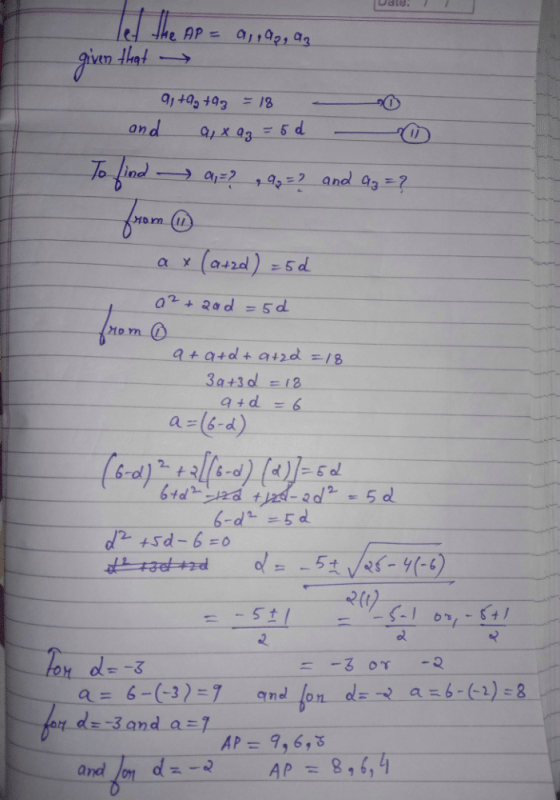Class 10 Exam > Class 10 Questions > The sum of the first three numbers in an AP i...
Start Learning for Free
The sum of the first three numbers in an AP is 18. If the product of the first and the third term is 5 times the common difference, find the three numbers .?
Most Upvoted Answer
The sum of the first three numbers in an AP is 18. If the product of t...
the terms are either 2,6,10 or 15,6,-3.
Step-by-step explanation:
It is given that the sum of first three numbers in an AP is 18. Product of the first and the third term is 5 times the common difference
Let first three numbers in the AP are a-d, a, a+d.
Sum of these three terms is 18.
Divide both sides by 3
The value of a is 6.
The product of the first and the third term is 5 times the common difference.
If the common difference is 4, then
Therefore the first three terms are 2, 6 and 10.
If the common difference is -9, then
Therefore the first three terms are 15, 6 and -3.
Community Answer
The sum of the first three numbers in an AP is 18. If the product of t...


|
Explore Courses for Class 10 exam
|

|
Similar Class 10 Doubts
Question Description
The sum of the first three numbers in an AP is 18. If the product of the first and the third term is 5 times the common difference, find the three numbers .? for Class 10 2025 is part of Class 10 preparation. The Question and answers have been prepared according to the Class 10 exam syllabus. Information about The sum of the first three numbers in an AP is 18. If the product of the first and the third term is 5 times the common difference, find the three numbers .? covers all topics & solutions for Class 10 2025 Exam. Find important definitions, questions, meanings, examples, exercises and tests below for The sum of the first three numbers in an AP is 18. If the product of the first and the third term is 5 times the common difference, find the three numbers .?.
The sum of the first three numbers in an AP is 18. If the product of the first and the third term is 5 times the common difference, find the three numbers .? for Class 10 2025 is part of Class 10 preparation. The Question and answers have been prepared according to the Class 10 exam syllabus. Information about The sum of the first three numbers in an AP is 18. If the product of the first and the third term is 5 times the common difference, find the three numbers .? covers all topics & solutions for Class 10 2025 Exam. Find important definitions, questions, meanings, examples, exercises and tests below for The sum of the first three numbers in an AP is 18. If the product of the first and the third term is 5 times the common difference, find the three numbers .?.
Solutions for The sum of the first three numbers in an AP is 18. If the product of the first and the third term is 5 times the common difference, find the three numbers .? in English & in Hindi are available as part of our courses for Class 10.
Download more important topics, notes, lectures and mock test series for Class 10 Exam by signing up for free.
Here you can find the meaning of The sum of the first three numbers in an AP is 18. If the product of the first and the third term is 5 times the common difference, find the three numbers .? defined & explained in the simplest way possible. Besides giving the explanation of
The sum of the first three numbers in an AP is 18. If the product of the first and the third term is 5 times the common difference, find the three numbers .?, a detailed solution for The sum of the first three numbers in an AP is 18. If the product of the first and the third term is 5 times the common difference, find the three numbers .? has been provided alongside types of The sum of the first three numbers in an AP is 18. If the product of the first and the third term is 5 times the common difference, find the three numbers .? theory, EduRev gives you an
ample number of questions to practice The sum of the first three numbers in an AP is 18. If the product of the first and the third term is 5 times the common difference, find the three numbers .? tests, examples and also practice Class 10 tests.

|
Explore Courses for Class 10 exam
|

|
Signup to solve all Doubts
Signup to see your scores go up within 7 days! Learn & Practice with 1000+ FREE Notes, Videos & Tests.


























